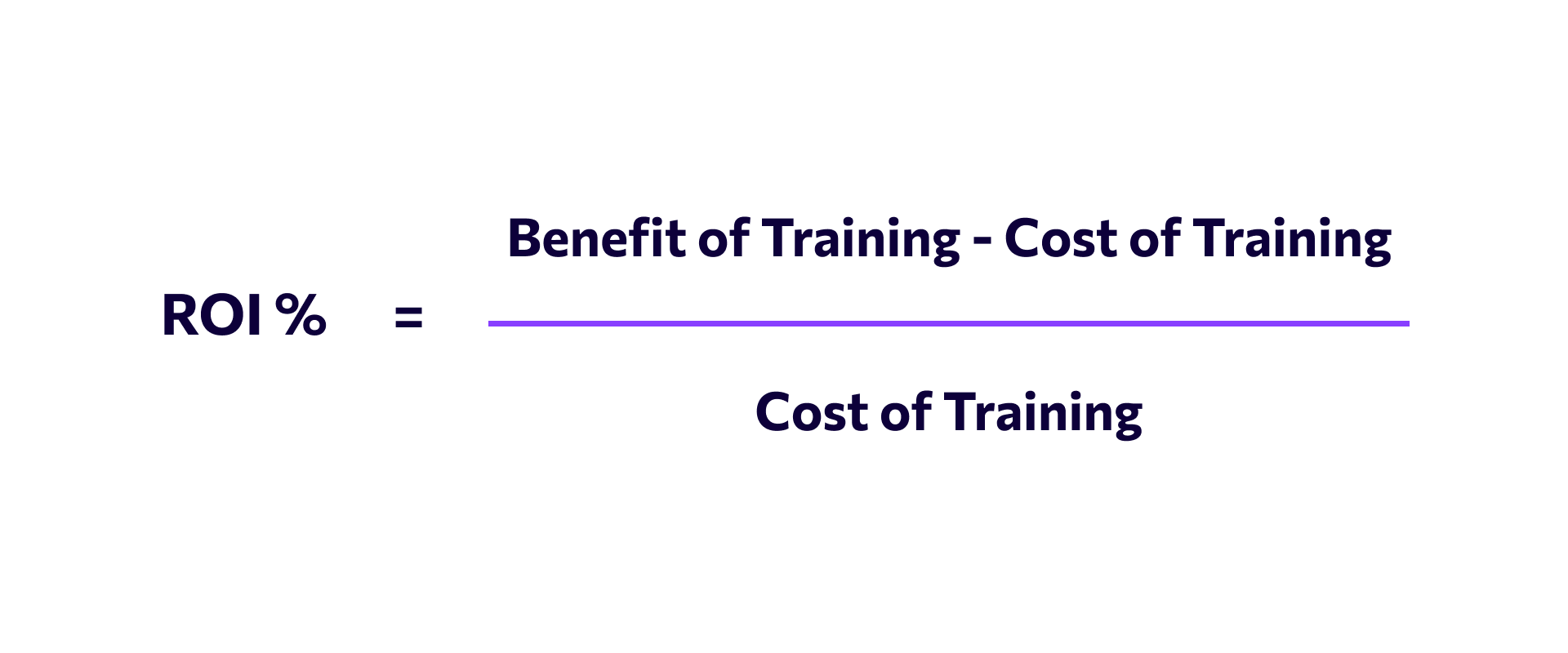Customer demands are changing. No longer content with just good products at competitive prices, consumers want a positive experience at every single touchpoint.
To meet this demand, companies are heavily investing in customer service, and rightfully so; with 90% of Americans using customer service as a factor when deciding whether or not to do business with a company.
The booming customer service industry is now worth a staggering $11.34 billion in 2022, yet not everyone is investing wisely. Companies looking to optimize their customer service via effective training need to figure out how to quantify training efficacy and justify their investment.
This can prove tricky for a service that both directly and indirectly impacts a plethora of business areas. However, that doesn’t mean it can’t be done.
Keep reading to find out how to calculate the ROI on customer service training, and how you can maximize your training investment.
Quick navigation:
- What's the impact of good customer service?
- How is customer service linked to training efficacy?
- How to measure ROI on customer service training
- How to maximize ROI on your training

What's the impact of good customer service?
Good customer service is about so much more than making sure your customer’s leave with a positive experience. It also benefits your business and your workforce. Struggling to see how? Below are just some of the ways good customer service influences your company.
Improves customer retention
Let's start with the business. Good customer service improves customer retention. In fact, three out of five customers agree that customer service heavily influences their loyalty to a brand. It’s also well known that existing customers are more profitable than new ones, making up on average 65% of a company’s total sales.
Greater retention means less need to attract new consumers—a process that is between five and twenty five times more expensive than retaining existing ones. However, if you do need to expand your customer base, great customer service helps with that too. Recommendations are an effective way to reach new customers, and those who judge a company’s service to be good are 38% more likely to recommend that company.
Drives sales
Your customer service team can also increase profit in a more direct way via driving sales. Imagine a consumer who is undecided whether or not to make a purchase. They approach a member of your customer service team, asking questions about the product. Someone lacking in product knowledge will appear uncertain, unable to provide reassurance that this product is worth investing in, and potentially drive the customer away.
Good service will have the opposite effect, instilling confidence in the consumer to make the purchase (and maybe more). The stats back this up - 54% of consumers make purchasing decisions based on customer service.
Improves employee retention
Good customer service encompasses more than just revenue growth, it can also improve employee retention. Excellent service comes from a combination of effective training and support. When employee’s feel supported in their job, and are given the skills to do their job well, they feel more motivated, engaged, and are less likely to leave the company.
In fact, companies with strong learning cultures see employee retention rates grow between 30%-50%, whereas 40% of employees who don’t receive the required training will leave a company within the first year.
How is customer service linked to training efficacy?
It’s important to note that customer service is a skill. It requires a deep knowledge pool and an understanding of how to interact with the variety of customers that your business deals with. And like all skills, it can be improved through effective training.
Let's start with product knowledge. In order to answer queries about products and services, your workforce must know everything about them. This can only be achieved through effective training. Ensure your workforce knows your products and services inside and out, so that they stand a better chance of providing an excellent customer experience. And if your business often changes its products—retail being one example— be sure to keep staff updated with continuous learning.
However, product knowledge is not enough—how you provide the necessary information is equally as important. It won’t always be a straightforward interaction where a customer asks and you answer. Some may not understand the terminology you use, instead requiring a more basic answer. Others won’t be satisfied with your answer, demanding more than your average consumer. Help your staff prepare for these hurdles with role-relevant training. Role playing is incredibly effective with helping staff deal with real-life customers. Continuous learning can be applied here too by making note of difficult real-life interactions and incorporating them into ongoing training.
How to measure ROI on customer service training
Calculating ROI on customer service training is no easy task because customer service indirectly impacts many business areas including workforce productivity, employee retention, and customer loyalty. It’s a spider's web of influence, and the threads aren’t easy to follow.
However, to successfully pitch the importance of training to internal stakeholders, you’ll need a method of calculation. So, where to start?
1. Define success
You can’t measure success if you don’t define what success is. Therefore the first step is to lay out which metrics are important to your business goals and will act as measurements for your investment.
There are a number of industries which depend heavily on the service they provide to customers, and the metric used to measure the quality of that service will differ across sectors. If you’re a hospitality business, you may want to measure a change in positive or negative reviews. If you’re in the retail industry, you might focus instead on the number of sales-per-employee.
For this example, we’re going to focus on retail - how can we prove that introducing customer service training to a department store has increased the number of sales per associate?
To calculate sales-per-employee, you’ll need to calculate your annual sales and divide that figure by the number of employees you have. Let's say this revealed a 15% annual increase in sales-per-employee —this proves your training was effective, right? Not quite. Although this proves something is working, you need to confirm it’s a direct result of your training.
2. Confirming your results
There are a number of factors that could influence a rise in sales-per-employee, so in order to prove it was a direct result of your training we recommend running an A/B test.
Create a control group consisting of the same demographic, but do not provide them with the training. Then compare the performance of this group to the group that received the training, providing you with a more accurate understanding of the efficacy of your customer service training and more compelling data to share with your stakeholders.
3. Calculating ROI
Now that you’ve decided on your metrics, it’s time to calculate your ROI using this formula: 
For this example, let's say the 15% increase in sales-per-employee equates to $300,000 increase in profit annually. This provides us with our figure for the benefit of training.
Next, we need to calculate how much the customer service training cost over the course of that year. The main components to consider are the cost of running the course (teachers, space, travel etc), hours lost to training rather than working, and the cost of creating and implementing the program.
In this instance, we’ll say the department store utilized a mobile-training platform that’s embedded into existing workplace tools. As the training is delivered entirely online, the cost of running the course is $0.
Delivering the training seamlessly via mobile allows sales associates to learn without disrupting their work flow. And because the content is delivered in 2-5 minute chunks, practically no work time is lost to training. That’s another $0.
All that remains is calculating the cost of content creation and implementation—lets say it costs $25,000.
Punch these numbers into the above formula, and that means our ROI is 1100%— a number that should impress your stakeholders and prove that your customer service training was a success.
How to maximize ROI on your training
Maximizing ROI on your training is simple—invest in the best training program possible in order to put your workforce in a position to succeed.
But what does a good training program look like?
With the widespread use of smartphones, a growing frontline workforce, and the stagnant results of traditional training methods, effective training has developed rapidly in recent times, and it’s important for industries to recognise these changes and adapt accordingly.
Microlearning is a way of delivering information in bite-sized pieces when it’s needed most. Tailoring to our shortening attention spans, microlearning engages the learner for 2-5 minutes, ensuring that focus isn’t lost and enhancing long-term knowledge retention by up to 80%.
It’s for these reasons why it pairs so perfectly with mobile learning. The bite-sized information that microlearning utilizes can be effortlessly delivered via technology that almost everyone has access to. Embedding learning into products that people already use is proven to increase engagement by 72% and productivity by 43%.
Furthermore, microlearning is cost-effective and time efficient. Learners complete courses faster and organizations spend less time creating and updating microlearning content than they would for a more traditional training program. There’s also no need to spend money on classroom space, teachers, or travel—your workforce are responsible for their own learning. All it takes is the click of a button.
eduMe is a mobile training platform that utilizes microlearning to engage your workforce and improve their performance. With the ability to seamlessly integrate into existing worktools, eduMe is a cost-effective and time efficient tool used by companies such as Uber, Marriott and Vodafone to drive better business results and increase their quality of service.
Get in touch with us now to find out more about what eduMe can offer your business 👇





